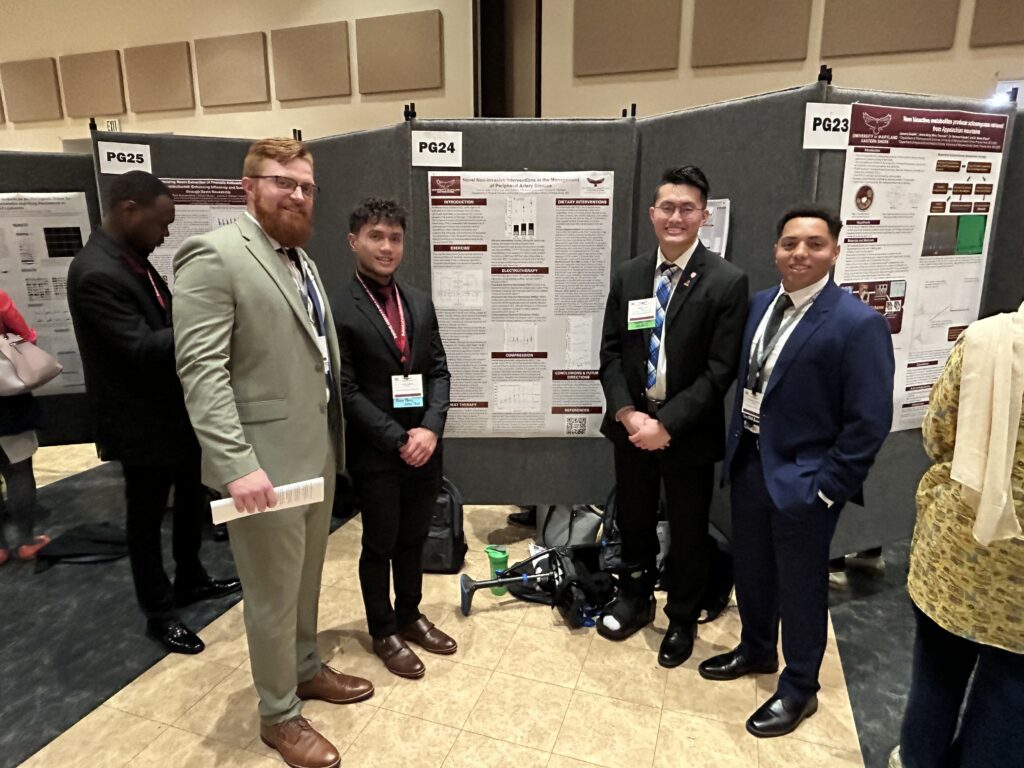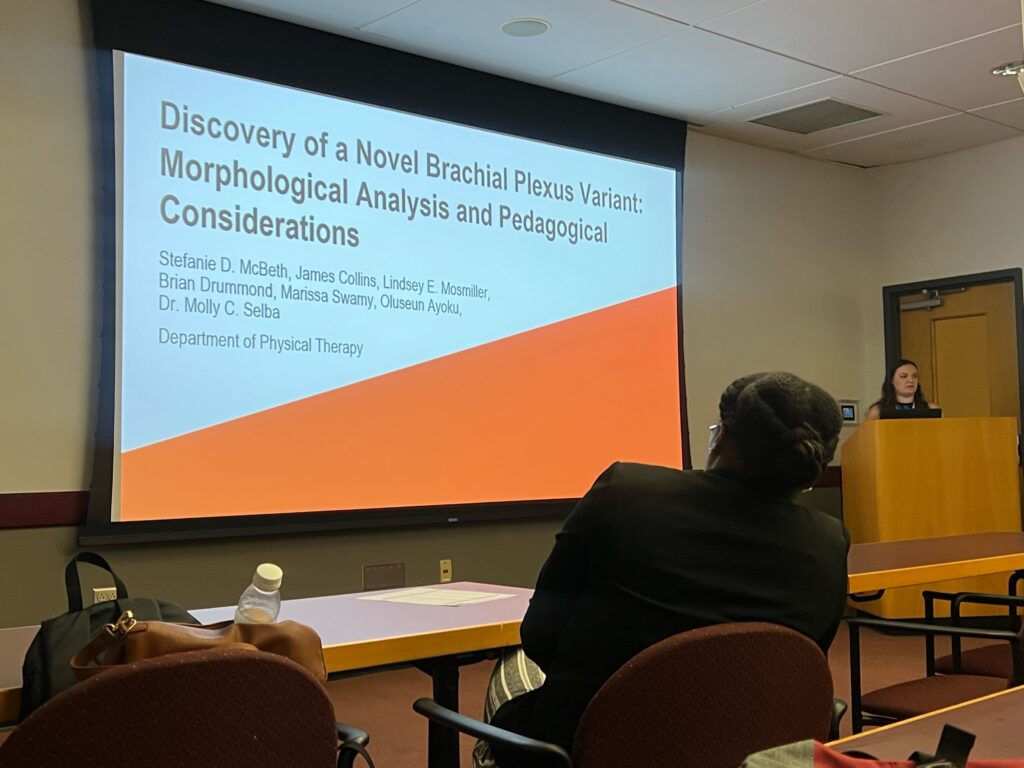14th Annual Regional Research Symposium 2024
Each Spring, the 3rd year students of the Department of Physical Therapy proudly present their research projects at the annual School of Graduate Studies Regional Research Symposium.
This year the PT Department had 1st/2nd Yr students in the Oral Graduate Presentation.
All information about the symposium can be obtained from the School of Graduate Studies. It is held in the Student Services Center. All interested students and faculty are invited to attend.
POSTER GRADUATE (PRESENTATIONS):

2nd Place Winner!
Title: Novel Non-Invasive Interventions in the Management of Peripheral Artery Disease
Advisor: Dr. Thomas Pellinger
Student Investigators: Joshua Hefta, Carl Suarez, Patrick Luo, Erotokritos Varlas
Peripheral artery disease (PAD), which affects an estimated 8-10 million Americans and 236 million individuals worldwide, is characterized by occlusive plaques in the arteries of the legs. The hallmark of PAD is pain in the legs with physical exertion known as claudication. PAD is associated with an increased risk of cardiovascular mortality and substantial medical expenditures, often including medications and surgeries that are costly, and sometimes accompanied by complications. Thus, the goal of this review is to highlight promising non-invasive interventions (NIT) in the management of PAD. Exercise significantly improves functional outcomes and quality of life (QOL) in patients with PAD. Current AHA recommendations support supervised exercise therapy (SET) as the primary NIT for these individuals, although barriers to SET include transportation and pain associated with activity. Recent studies exploring the efficacy of home-based exercise, variations in exercise intensity, and non-traditional exercise regimens, have yielded equivocal results, suggesting the need for ongoing research in this area. Recently, investigators utilizing heat therapy in patients with PAD have found that full body and lower limb heating have each induced improved hemodynamics and ambulation. Both acute and long-term hot water submersion protocols have yielded convincing data showing positive effects on limb blood flow and 6-minute walk distance (6MWD) in this population. Electrotherapy has emerged as another potential NIT in the management of PAD. Effects of neuromuscular electrical stimulation, functional electrical stimulation, and transcutaneous electrical stimulation (TENS) have been examined. Although electrotherapy research is ongoing, thus far, the most compelling data have shown TENS to be effective in improving limb blood flow and exercise capacity in patients with PAD. The effects of compression therapy, including intermittent pneumatic compression (IPC), intermittent negative pressure therapy (INP), and graduated compression stockings have also been studied in patients with PAD. Administration of IPC has been shown to evoke sustained improvements in initial claudication distance, absolute claudication distance, and walking distance comparable to supervised exercise. In addition, 24 weeks of INP improved pain-free walking distance and maximal walking distance (MWD) in this population. Finally, several investigators have examined the impact of various dietary interventions on functional capacity in patients with PAD. For instance, acute beetroot supplementation has induced improvements in claudication onset time and MWD, whereas 6 months of daily cocoa consumption has led to an increase in 6MWD in this population. In conclusion, various safe and affordable NITs show promise for improving QOL in patients with PAD.

3rd Place Winner!
Title: Effects of Consistent, Self-Selected Physical Activity on Physical Performance and Quality of Life for Employees in an Office Setting: A Pilot Study
Advisor: Dr. Stephanie McAllister
Student Investigators: Valerie Hammett, Angela Skolnitsy, Paige Wilde, Evan Cord, Amanda Irwin
Physical activity and its impact on general health have been extensively investigated in the literature. Many studies exploring the relationship between exercise and health in office workers have incorporated methods using a standardized program or have used a pedometer to quantify physical activity. There is a paucity of research investigating physical activity, measured by the duration and intensity, as recommended by published guidelines. The purpose of this pilot study was to examine the effects of self-selected physical activity using recommended parameters on endurance, strength, health, and quality of life (QOL). We hypothesized that there would be improvements in physical performance measures and self-reported health and quality of life, as well as subject attrition. Intra-rater and inter-rater reliability were established for the student investigators (ICC≥0.96). A convenience sample from a local non-profit agency was recruited for this observational longitudinal study. Participants performed the Six Minute Walk Test (6MWT), 30 Second Chair Stand Test (30CST), grip strength, and self-reported measures including the Short Form-36 and the 5-Item Physical Activity Questionnaire at baseline, 6 weeks, and 12 weeks. At baseline, subjects were educated on the benefits of physical activity, recommended guidelines of duration and intensity, types of exercises with pictures, and provided an activity log to track daily physical activity. Statistical analyses included descriptive statistics, Pearson’s correlations, repeated-measures ANOVA, and non-parametric tests. Significance was established at p<0.05. Nineteen subjects participated in baseline testing, but only 11 subjects, mean age of 51 years (SD=16) and 73% female, were included in the final data analysis. There was a significant difference in 6MWT and 30CST performance from baseline to 12 weeks. Grip strength was strongly correlated with average minutes of physical activity at 6 weeks (r=0.80, p<0.05) and 12 weeks (r=0.88, p<0.01). There was a significant reduction in the average minutes and intensity of physical activity reported from 6 weeks to 12 weeks. The findings of this pilot study indicate interventions of education and physical activity improve endurance and strength in office workers but do not significantly change self-reported health and QOL. Results also suggest adherence and consistency with physical activity duration and intensity decrease over time. Future studies investigating physical activity and the relationship between self-reported health and QOL are warranted.

Title: The Effect of Pelvic Positioning and Shoewear on Gluteus Medius Activation
Advisor: Dr. Michael Rabel
Student Investigators: Ibukun Lawal, Matthew Mannick, Jerome Thomas, Brendan Born, Nicholas Rabat
The importance of optimal gluteus medius recruitment during functional weight-bearing activities is well established. This muscle has a clear role in maintaining proper pelvic alignment during single limb stance and lower extremity weight shifting. While studies have examined specific exercises for optimal recruitment, evidence is limited regarding the influence of pelvic positioning (anterior or posterior pelvic postures) on the activation of this muscle, especially during unilateral stance. Therefore, the aim of this descriptive cross-sectional study was to determine the influence of pelvic positioning and shoewear (shoes-on or shoes-off) on the activation of the gluteus medius during single-leg stance. Surface electromyography was used to evaluate muscle activation in 20 active, asymptomatic volunteers during 3 pelvic variations of the single leg stance exercise, with shoes on and off. Electromyographic signals were recorded from the gluteus medius of the dominant lower extremity and normalized data were examined using a 2-way, repeated-measures analysis of variance with factors of pelvic positioning and shoewear. No significant shoewear × pelvic angle interaction (p>0.05) was observed. However, shoewear had significant main effects on muscle activation (p<0.001). Post hoc analyses showed that while there were no significant differences between pelvic positions, significant differences were identified between wearing and not wearing shoes. The shoewear factor significantly (p<0.001) increased gluteus medius activation (Shoes-On to Shoes-Off: Neutral Pelvis 14.8 ± 7.4 to 20 ± 3.9; Δ%:35.2, Anterior Pelvis 12.5 ± 6.2 to 19.3 ± 8; Δ%:54.4; Posterior Pelvis 11.7 ± 4.7 to 21.3 ± 13.4; Δ%:82.1). In all pelvic positions, the magnitude of gluteus medius activation in single limb stance was significantly greater when the shoes were off. Also, a posterior pelvic position is advocated to optimize the recruitment of the gluteus medius during unilateral weight-bearing exercises. These findings encourage clinicians to consider pelvic mobility as well as the interaction between the ground and the foot when designing optimal exercise programs for the gluteus medius.
ORAL GRADUATE (PRESENTATION):

Title: Discovery of a Novel Brachial Plexus Variant: Morphological Analysis and Pedagogical Considerations
Advisor: Dr. Molly C. Selba
Student Investigators: Stefanie D. McBeth, James Collins, Lindsey E. Mosmiller, Brian Drummond, Marissa Swamy, Oluseun Ayoku
Understanding the components of the brachial plexus, its relationship with surrounding structures, and its variants is of vital importance in educational, clinical, and surgical settings. The specific combination of variants presented in this case report has not been identified simultaneously in the same donor. We performed a routine cadaveric dissection of the cervical region of a 94-year-old male. Anomalous findings were noted on the right side, including combined variations in the trunks, divisions, and contributions. Three trials of bilateral caliper measurements of the nerves were recorded. Additionally, a bilateral visual analysis of relevant musculature was performed. As a result of our analyses, we found there to be non-fusion of the right upper trunk. The suprascapular nerve was found branching from the C5 root only. Trunks I-IV contribute anterior and posterior divisions to each associated cord. Findings following caliper measurements are as follows: 2 upper trunks of the variant side were larger than the non-variant side upper trunk, the posterior cord was the same diameter on each side, the median nerve was larger on the variant side, and the suprascapular nerve was smaller on the variant side. Morphological analysis of related musculature found that there was no apparent difference in size between the right and left infraspinatus muscles but a slight difference was noted that the right supraspinatus muscle appeared thicker. Upon discovery of the diameter size difference between the variant and non-variant sides, we considered the relationship between anatomical variants and common sites of compression. This is of interest clinically as there could be complications when it comes to medical interventions and procedures. Specifically, this variant is notable as compression of C5 VPR would result in drastic effects on the muscles innervated by the suprascapular nerve, which would not be the case with typical morphology. In order to investigate how we can best teach complex morphology like what was observed in our donor, we did a follow-up study presenting a lesson on these structures to 46 students at the University of Maryland Eastern Shore who were randomly assigned into 2 groups: one group received didactic instruction on the observed variant while the other received additional 3D-printed learning materials. Performance outcomes and metrics assessing confidence were not found to be statistically significant, however, enjoyment and recommendation of visualization resources were found to be statistically significant. The results of this study encourage future research surrounding the role of enjoyment/engagement in anatomy education.


